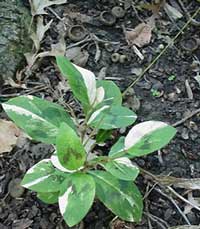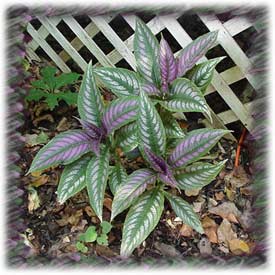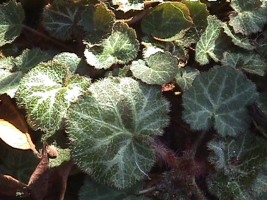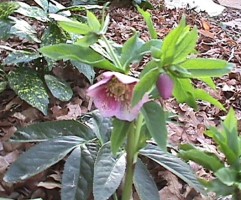
| home | club | plants | critters | in
the garden |
in
the home |
in
the news |
North
TX calendar |
|
|

|
||||||||||
|
|||||||||||
|
Shade Gardening Archives - D.
Barnett January '01 Feature:
The leaves of this plant are shaped like an angel wing begonia. It normally blooms in late spring to frost. The flowers of this begonia are pale pink held loosely above the leaves. There are tiny bulb-like tubers that appear at the leaf joints in late summer. These can be used to increase your stock or to pot up and share with a fellow gardener. This plant needs shade and moist well-drained soil. A brother or sister plant to this one is Begonia grandis 'Alba'. Alba has a wonderful white bloom and needs all of the conditions listed above. I have had a small start of this plant for three years. It is the smallest plant in my garden. It just sits there and has never bloomed for me yet. The jury is still out on this one! Begonia grandis will need extra watering in the hot summer. In the winter it will freeze to the ground and leave no visible signs that it was ever there. Do not give up on it for this plant will come back with a vengeance the next year. If that is not good enough for you, look under the leaves of the plant and you will see a whole bunch of new plants coming up. This is the plant I pot up every year. It is best to get them potted up as soon as possible, while they are still small plants. I grow my begonias with wood fern in the background. They are truly a wonderful sight together. As I usually say in this column, this plant is a true Texas star for the garden, in addition to, a superb southern heirloom perennial. October Feature: Tovara is a plant that has just the right color of foliage to brighten up any shady spot. It prefers rich, moist soil with light shade to half a day of sun. The more sun it gets the taller it will grow. The only problem with that is the sun will bleach out the wonderful colors of the leaves.  The
book on this plant is 18" to 24" tall, 6" to 12" wide and Zone 4-9. As I
stated earlier it will grow taller in the sun, but it will grow shorter
in the shade to filtered shade. I have grown this plant for approximately
5 years now and I have seen it grow 3" to 6" in the shade, but it still
blooms and does just fine. The
book on this plant is 18" to 24" tall, 6" to 12" wide and Zone 4-9. As I
stated earlier it will grow taller in the sun, but it will grow shorter
in the shade to filtered shade. I have grown this plant for approximately
5 years now and I have seen it grow 3" to 6" in the shade, but it still
blooms and does just fine. So now lets talk about the leaves. The green leaf has a central red-brown to burgundy area, with ivory to yellow-white splashes in an overall deep pink tinge. In a nutshell, no two leaves are ever the same color or contrast. One leaf might be greener, redder, whiter, or any mix of colors than any of the other plants growing right beside it. Tovara blooms in mid- to late spring, and has airy spikes of small red bead-like blooms. It tends to spread by reseeding itself in the same general area, however it is very controllable. Sometimes this plant is listed under Polygonum or Fallopia. I must say I have traded this plant at plant swaps all over Texas and I just recently sold 5 flats of this wonderful plant at the Arlington Organic Garden Clubs' plant sale. It is always the first plant to sell, which shows you how wonderful it is. I recommend this one above all other plants. This is a tried and true shade plant for the state of Texas. August Feature: Persian Shield This plant is a soft-stemmed shrub. The color is hard to describe if you have not seen the plant, but I will give it a try.  The
leaves are in pairs and have an elliptical shape. The top of the leaf is
a dark green with an iridescent silver/purple overlay that looks like it
has been painted on. The leaf color can change depending on the light level.
The underneath side of the leaf is dark purple. It resembles a metallic
glittering jewel. The
leaves are in pairs and have an elliptical shape. The top of the leaf is
a dark green with an iridescent silver/purple overlay that looks like it
has been painted on. The leaf color can change depending on the light level.
The underneath side of the leaf is dark purple. It resembles a metallic
glittering jewel. This plant holds its color well and will grow great in pots. In the house it will need a sunroom or a bright window. The book on this plant claims it has short spikes of funnel-shaped pale blue flowers. They are 1¼ inches long and are produced in the autumn (I didn't know Burma had an autumn). I have never had this happen in my yard, it always freezes before the bloom comes. Height 4ft Width 3ft Zone 9-11. I have grown this plant in zone 8 for three years now with filtered light to some sun. It needs a little extra water in the hot summer. This plant dies to the ground with the first freeze. I usually add a little extra mulch on top when real cold weather threatens to help protect the roots. Don't give up on this plant it will come back the following spring, just as soon as the ground heats up enough. You just can not get this color with any other plant. It is most definitely a keeper and should be used more often. July's Feature: Ligularia (lig-you-lay-ri-a) tussilaginea 'Aureo Maculata'Leopard Plant Ligularia has the most remarkable bold foliage of almost any plant. This evergreen plant originated in Japan and was brought back during the Victorian Era to be used in greenhouses and in some borders. The beauty of this plant has only recently been rediscovered. The Leopard plant is a vigorous, rhizomatous, mostly evergreen perennial, which grows in zones 7-10. The leaves of the Leopard plant are to die for. They are large, rounded, and dark green in addition to being
The Leopard plant needs rich, moist, even boggy soil, in light shade to some sun. Full shade or full sun will kill this plant in a Texas minute. Too much sun and the leaves will burn or worse, bleach out the wonderful yellow dots. This plant will need some supplemental watering in the heat of summer. There are also three very rare forms of this plant. Green leaves with pink dots, green leaves with white dots and my favorite green leaves with a variegated white gently flowing back from the end of the leaf. I would like to have all of these, so keep a eye out for me. I have grown the Leopard plant for several years and I just love it. The yellow dots are never the same on any one leaf. This plant is a little hard to find and pricey ($12-$24 per gallon) but you will be rewarded with a wonderful woodland plant. May's Feature: Chinese Ground Orchid (Bletilla striata) Bletilla (Hardy Orchid) is another must for the woodland garden. This is the only orchid that we can grow in the ground. These hardy spring flowering orchids prefer a slightly moist or humusy garden soil. The only thing this orchid does not like is dry soil and full sun. This orchid grows upright, heavily textured, iris-like green leaves 10" x 1" wide, forms a slowly spreading clump. In the early
I have had only one problem with these plants. If the winter is mild and they start to come up early, a late freeze can damage them. I suggest overing them until the threat of frost is completely gone. If you have thought that orchids were difficult to grow, then you have to try this orchid!
April's Feature: Strawberry Begonia or Geranium Saxifraga Stolonifera This ground cover is not a strawberry or a geranium or even a begonia. This is one of the finest and one of the most bizarre ground covers around. The Strawberry Begonia is a low growing ground cover with a nice spreading habit. It produces dainty white flowers on spikes held high above the foliage. The leaves are lime green to medium green with silver veins and reddish undersides. It spreads like a strawberry plant, forming new baby plants at the end of slender runners. It prefers shade to filtered sunlight, however, I  have
some growing in direct afternoon sun (2 to 3 hours) and it has done quite
well. I had some growing in dense shade, but it did not survive. This ground
cover grows well in zones 7-10. It is a ground cover normally grown in a
greenhouse. In addition, it grows well in hanging baskets. I had to give
it a little extra watering in the summer months but other than that it has
proven to be a real trooper in the garden. My experience this winter was
no die back and the sleet storm we encountered did not hinder it. It is
a phenomenal ground cover for lightly shaded areas. have
some growing in direct afternoon sun (2 to 3 hours) and it has done quite
well. I had some growing in dense shade, but it did not survive. This ground
cover grows well in zones 7-10. It is a ground cover normally grown in a
greenhouse. In addition, it grows well in hanging baskets. I had to give
it a little extra watering in the summer months but other than that it has
proven to be a real trooper in the garden. My experience this winter was
no die back and the sleet storm we encountered did not hinder it. It is
a phenomenal ground cover for lightly shaded areas. March's Feature: Lenten Rose (Helleborus orientalis) This Lovely flowering perennial thrives with little care and is a must for the shade garden. This plant flowers in the late winter to very early spring. It forms a nice cluster of deeply divided glossy leaves. In the late fall this cluster opens up and the old leaves drop away from the newly emerging leaves. The semi-nodding flowers will self-sow and form long-lived colonies. I am still waiting for the blessed event.  Lenten
Rose needs humusy, evenly moist, neutral or alkaline soil. It needs morning
sun and dappled or filtered afternoon shade is a must. That is what the
book says, I grow mine in filtered light under a large oak tree and dogwood
tree and it does just fine. As the plant matures (after two years) the more
tolerant to the heat of summer it will become. You can remove any old or
damaged leaves as needed. Lenten
Rose needs humusy, evenly moist, neutral or alkaline soil. It needs morning
sun and dappled or filtered afternoon shade is a must. That is what the
book says, I grow mine in filtered light under a large oak tree and dogwood
tree and it does just fine. As the plant matures (after two years) the more
tolerant to the heat of summer it will become. You can remove any old or
damaged leaves as needed. It grows in Zone 4-9, 15" tall and 24" wide. The flower of orientalis can range from white, to red, to deep lavender. I have had H. orientalis growing at my house for the last three years. It has bloomed only two of those years. If the winter is mild you might not get a bloom, but have an ice storm like we had this year and you are guarantied a wonderful bloom (as the pictures illustrate). So, to sum it all up, H.orientalis is a little expensive ($7.99 and up) but this evergreen flowering perennial is a must for your shade border. It will give a little character to any area you have that you need a great shade plant. February's Feature: Heuchera (HEW-kur-ah) This woodland plant has recently undergone a huge resurgence in popularity. The trail blazer plants that have caused this popularity to re-emerge are H. "Palace purple" and H. "Montrose ruby". Thanks to all the plant breeders in the world we have several kinds of new Heuchera. The following list is just a sample:
Heuchera is hardy in zones 4-9, and grows to 12" high and 18" wide. Propagate in early spring or late fall. Just give Heuchera a nice humusy area to grow and keep an eye on it for at least the first year and during the summer season. This wonderful low growing plant with its different looking leaves is truly a keeper. Most definitely a plant to try. Mail order catalogs may be your only source to obtain some of the newest hybrids. The prices range from $3.99 to $9.00. Do look around at your local nurseries and ask for them by name: Heuchera. January's Feature: Cast Iron Plant (Aspidistra eliator) To begin, let's talk about the Cast Iron Plant (Aspidistra eliator). It is an evergreen that grows in two forms: a dark green foliage and a variegated foliage (Aspidistra elatior 'Variegata). The Cast Iron plant is native to Japan. This is truly a great plant. It is not called Cast Iron for nothing. It is extremely tough and drought tolerant (once it is established). A real cold winter will fray and brown the tips of the leaves and they will look pretty bad. Cutting away the bad and leaving the good can solve this problem. New leaves will be coming up from the ground in the middle of spring.
The 'Variegata' form of Cast Iron is really something to see. The variegation runs in stripes of white on the dark green leaf. Too much fertilizer will cause this plant to lose it's Variegation and the leaves will turn back to green. It is beautiful in the back of a dark garden bed or in an area you need to brighten up. It costs more than the standard Cast Iron Plant, usually double the price. It is definitely worth a try and is clearly a keeper. So to sum it all up if you are looking for a plant to put into a dark garden area and you just want to plant it and forget it this is a must. Darwin himself would be a happy Gardener with this plant………….. |
||||||||||||